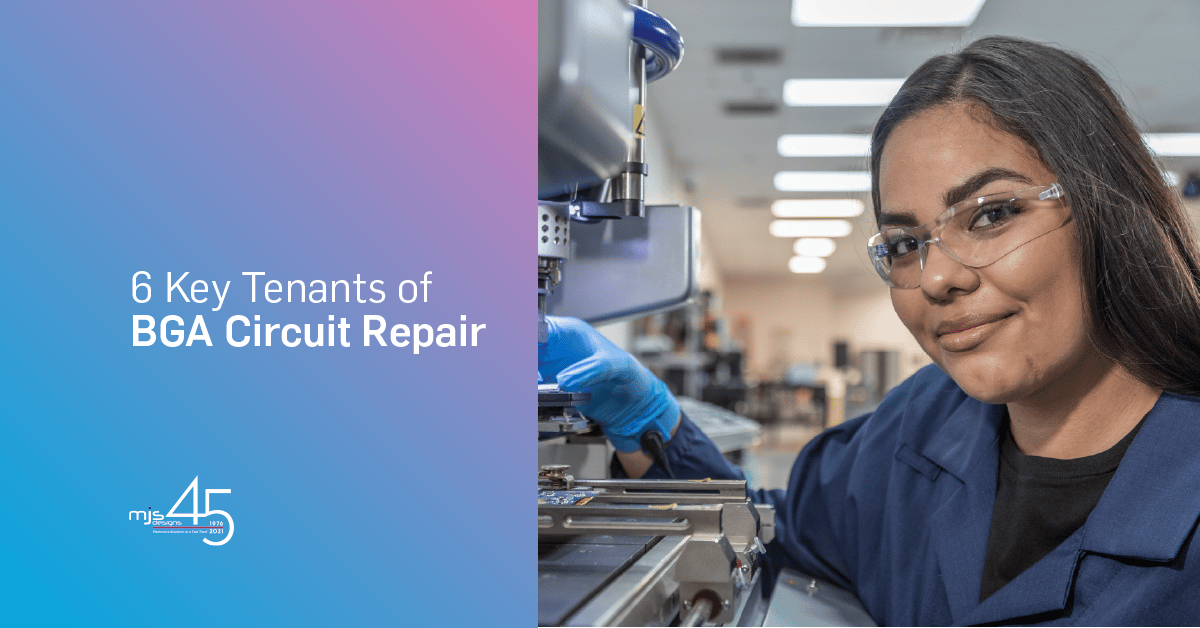Rework on ball grid arrays is one of the trickiest tasks carried out in assembly plants and service depots all over the world. The rework technician’s abilities and knowledge play a significant role in correctly repairing the circuit board. That is why we say that a BGA rework has elements of both science and art.
There are six crucial aspects of the well-defined and established BGA rework procedures. Failing to follow these can be expensive and result in several negative outcomes.
Some of these negative outcomes are:
- Excessive joint voiding. This is frequently the result of choosing the wrong solder paste or using the wrong process parameters. Doing this can jeopardize the attachment’s integrity, necessitate further rework, or lead to rejection if the voiding is greater than 25%.
- BGA Pad deterioration during BGA removal. This unavoidable risk is sometimes made worse when conformal coatings and underfill are employed.
- Inadequate solder, joint bridging or BGA orientation. This entails more thermal cycles of rework and an elevated risk of damage with each subsequent application of heat.
These issues can be avoided with an experienced PCB assembler and accurate process. Therefore, let’s examine the six most common BGA rework tenants and how following them can help.
1. Adequate Operator Education
The skills of BGA rework technicians must be extensively developed and practiced. They need to comprehend the components to be repaired, the tools, the steps in the process, and how everything is related. Therefore, before beginning circuit board repairs, the technician must be able to competently and knowledgeably assess the BGA rework. Additionally, they must be able to spot the subtle, telltale signals that the process is off course.
2. Suitable Equipment
The equipment used for BGA rework needs to be sophisticated, adaptable, and capable of supporting a controlled, predictable, and repeatable operation. This comprises product removal and replacement capabilities, closed-loop thermal sensing and control, and the durability to supply heat as needed by the process. Therefore, make sure you are using the most capable equipment you can get.
3. Good Profile Development
The BGA rework profile is similar to the assembly reflow profile and is just as crucial. Without it, an effective and repeatable BGA rework procedure would be impossible.
A poorly-developed thermal profile may cause damage to the circuit card assemblies or BGA components. This can result in the need for more rework cycles at the same location and damage or reflow of nearby components. The development of good profiles requires careful consideration of thermocouple placement and data analysis.
4. Adequate Preparation
Preparation is required before the first heat cycle is applied to a BGA rework site if the procedure is to be carried out correctly. This entails removing or protecting neighboring heat-sensitive components to prevent damage or unintentional reflow. Additionally, it means baking out moisture from the BGA device and the board assembly to prevent popcorning and other difficulties.
The appropriate choices must be taken in advance, including whether to use solder paste, what type of flux, which solder paste stencil to use, and which alloys to utilize. Additionally, a thorough evaluation of the PCB is required for missing or contaminated pads, solder mask damage, component damage, and solder ball size and co-planarity.
5. Taking into Account all Heat Effects
Reflowing nearby component solder connections causes various new rework concerns. These include oxidation, insufficient solder, de-wetting, wicking, pad and lead damage, component damage, and other problems.
Therefore, the technician must be continually aware of how heat influences the target BGA device and other components on both sides of the assembly that are close to it. A well-designed profile and stringent process control are necessary to minimize the effects of heat outside of the component being worked on.
6. Post-Placement Inspection
The area under a BGA component is impossible for the technician to see without modern X-ray equipment. However, with X-ray inspection equipment issues like excessive voiding and inadequate placement or alignment can be found right away.
However, just like a radar operator, an operator of an X-ray system needs the right training to properly decipher and comprehend the image that the device is producing. Therefore, getting the most out of this expensive and necessary equipment investment is necessary. This is especially true given the complexity of BGA component.
Looking for the Highest Quality Circuit Board Repairs?
Our experienced rework technicians at MJS Designs have extensive background in the removal and replacement of CCGA’s, BGAs, uBGAs, CSPs, LGAs, QFNs, Interposers, Specialized Pin Adapters, Package on Package (PoP) and BGA type connectors. We also offer 100% 3D X-ray inspection. And much more.
Contact us today for a quote for your printed circuit board assembly repair requirements.

